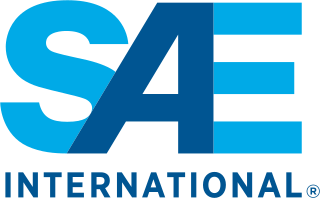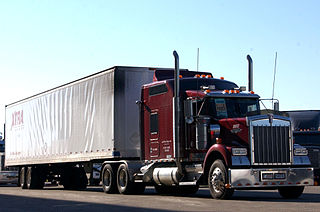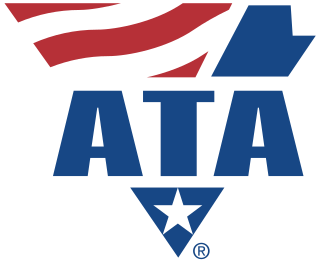
In transportation, platooning or flocking is a method for driving a group of vehicles together. It is meant to increase the capacity of roads via an automated highway system.

A self-driving car, also known as an autonomous car (AC), driverless car, or robotic car (robo-car), is a car that is capable of operating with reduced or no human input. Self-driving cars are responsible for all driving activities including perceiving the environment, monitoring important systems, and controlling the vehicle, including navigating from origin to destination.

SAE International is a global professional association and standards organization based in Warrendale, Pennsylvania, United States. Formerly the Society of Automotive Engineers, the organization adopted its current name in 2006 to reflect both its international membership and the increased scope of its activities beyond automotive engineering and the automotive industry to include aerospace and other transport industries, as well as commercial vehicles including autonomous vehicles such as self-driving cars, trucks, surface vessels, drones, and related technologies.
Hydrogen fuel enhancement is the process of using a mixture of hydrogen and conventional hydrocarbon fuel in an internal combustion engine, typically in a car or truck, in an attempt to improve fuel economy, power output, emissions, or a combination thereof. Methods include hydrogen produced through an electrolysis, storing hydrogen on the vehicle as a second fuel, or reforming conventional fuel into hydrogen with a catalyst.

Vehicular automation involves the use of mechatronics, artificial intelligence, and multi-agent systems to assist the operator of a vehicle such as a car, lorries, aircraft, or watercraft. A vehicle using automation for tasks such as navigation to ease but not replace human control, qualify as semi-autonomous, whereas a fully self-operated vehicle is termed autonomous.
The United States Army DEVCOM Ground Vehicle Systems Center (GVSC) (formerly United States Army Tank Automotive Research, Development and Engineering Center (TARDEC)), located in Warren, Michigan, is the United States Armed Forces' research and development facility for advanced technology in ground systems. It is part of the U.S. Army Combat Capabilities Development Command (DEVCOM), a major subordinate command of the U.S. Army Futures Command. GVSC shares its facilities with the United States Army Tank-automotive and Armaments Command (TACOM). Current technology focus areas include Ground Vehicle Power and Mobility (GVPM), Ground System Survivability and Force Protection, among others.

Energy-efficient driving techniques are used by drivers who wish to reduce their fuel consumption, and thus maximize fuel efficiency. Many drivers have the potential to improve their fuel efficiency significantly. Simple things such as keeping tires properly inflated, having a vehicle well-maintained and avoiding idling can dramatically improve fuel efficiency. Careful use of acceleration and deceleration and especially limiting use of high speeds helps efficiency. The use of multiple such techniques is called "hypermiling".
SmartDrive Systems, Inc. is a driver safety and transportation intelligence company located in San Diego, California. The company uses video and driver data to monitor driver behavior in commercial vehicles including trucks, buses and trains.

The trucking industry serves the American economy by transporting large quantities of raw materials, works in process, and finished goods over land—typically from manufacturing plants to retail distribution centers. Trucks are also used in the construction industry, two of which require dump trucks and portable concrete mixers to move the large amounts of rocks, dirt, concrete, and other building materials used in construction. Trucks in America are responsible for the majority of freight movement over land and are tools in the manufacturing, transportation, and warehousing industries.

The American Trucking Associations (ATA), founded in 1933, is the largest national trade association for the trucking industry. ATA represents more than 37,000 members covering every type of motor carrier in the United States through a federation of other trucking groups, industry-related conferences, and its 50 affiliated state trucking associations. Former Governor of Kansas Bill Graves was replaced by Chris Spear as the ATA's president and CEO in July 2016.
Westport Innovations is a company that develops alternative fuel, low-emissions technologies to allow engines to operate on clean-burning fuels such as compressed natural gas (CNG), liquefied natural gas (LNG), hydrogen and biofuels such as landfill gas. Headquartered in Vancouver, British Columbia, Canada, where the company was founded, Westport also has facilities in France, Sweden, Italy, China, Australia and the United States.

Safe Road Trains for the Environment (SARTRE) is a European Commission-funded project to investigate and trial technologies and strategies for the safe platooning of road vehicles, a transportation concept in which several vehicles are electronically linked together in a "road train", with only the lead driver in active control. The three-year project was launched in 2009. The research and development was carried out by several European auto manufactures with Volvo at the lead. A first practical test successfully took place in December 2010. In September Volvo announced that the SARTRE research project had come to a close, and that the company was ready to look into putting its finished product on the road.
Achates Power is an American developer of opposed-piston, two-stroke, compression ignition engines for use in commercial and passenger vehicles. Based in San Diego, California, the company was founded in 2004 by James U Lemke.

Experiments have been conducted on self-driving cars since 1939; promising trials took place in the 1950s and work has proceeded since then. The first self-sufficient and truly autonomous cars appeared in the 1980s, with Carnegie Mellon University's Navlab and ALV projects in 1984 and Mercedes-Benz and Bundeswehr University Munich's Eureka Prometheus Project in 1987. Since then, numerous major companies and research organizations have developed working autonomous vehicles including Mercedes-Benz, General Motors, Continental Automotive Systems, Autoliv Inc., Bosch, Nissan, Toyota, Audi, Volvo, Vislab from University of Parma, Oxford University and Google. In July 2013, Vislab demonstrated BRAiVE, a vehicle that moved autonomously on a mixed traffic route open to public traffic.
Torc Robotics (Torc), an independent subsidiary of Daimler Truck, is an American autonomous truck company headquartered in Blacksburg, Virginia, with operations in Albuquerque, New Mexico; Austin, Texas; and Stuttgart, Germany. Torc is testing autonomous trucks in Virginia, New Mexico, and Texas and is taking a pure play approach to commercialization – focusing at first on one platform in one region.

A self-driving truck, also known as an autonomous truck or robo-truck, is an application of self-driving technology aiming to create trucks that can operate without human input. Alongside light, medium, and heavy-duty trucks, many companies are developing self-driving technology in semi trucks to automate highway driving in the delivery process.

The Megawatt Charging System (MCS) is a charging connector under development for large battery electric vehicles. The connector will be rated for charging at a maximum rate of 3.75 megawatts.
Motive is a technology company that builds products to improve the safety, productivity, and profitability of businesses that power the physical economy.
Plus is an American autonomous trucking technology company based in Cupertino, California. The company develops Level 4 autonomous trucking technology for commercial freight trucks. In 2019, the company completed the first cross-country driverless freight delivery in the U.S. The company's self-driving system began to be used commercially in 2021.
Gregory Matthew Shaver is an American mechanical engineer and an academic. He is the director of Ray W. Herrick Laboratories and is a professor at Purdue University.











